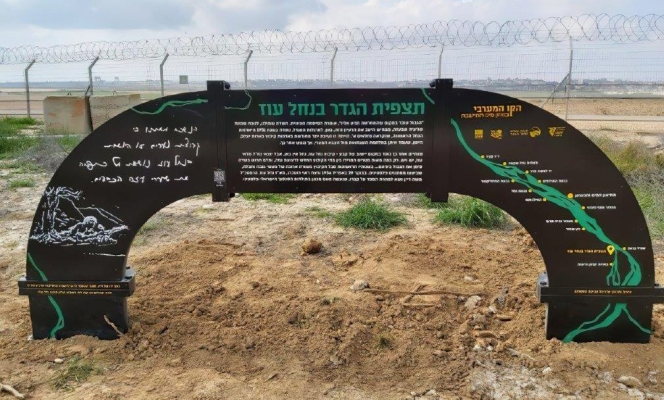Nahal Oz - Fencing with Gaza
As, yet again, last Saturday evening hundreds of thousands of Israelis demonstrated against their government's proposed drastic judicial reforms, taking to the streets of Tel Aviv, Haifa and other towns and cities throughout Israel, residents of Kibbutz Nachal Oz on the Israel-Gaza border were running to the closest security room, sirens wailing as a rocket fired from Gaza exploded nearby – yet again!
In a large building that from 1959-1976 housed the Nachal Oz community dining room, before becoming a cultural center and eventually present day Oz Ba-Negev Visitor Center and Art Gallery, an extraordinary exhibition of photographs is on display. The photographs are the work of photographer Batia Holin from nearby Kibbutz Kfar Aza – and also of a young photographer from neighboring Hamas-run Gaza, which is within sight and earshot of parts of Nachal Oz and far too close for comfort.
For a number of years Holin has been taking photographs with her mobile phone during her daily walks along the perimeter fence of Kfar Aza and elsewhere in the region known as "The Gaza Envelope". She decided to try and make contact with photographers on the other side of the divide between Gaza and the Israeli communities that straddle the border between them.
Through various electronic means, Batia was able to make contact with a handful of Gazan Palestinians who were also avid photographers, and gradually the idea began to develop sharing their photographs, in order that others could share in the sights and sounds from 'both sides of the divide'.
"Initially, there were quite a few responses, but then little by little the number dropped as the Palestinians began to fear repercussions should they be discovered 'collaborating' with Israelis," explained Holin.
"Eventually, just one young man, whom we have given the pseudonym Mohammad to protect his identity, remained in contact and the idea of an exhibition developed as the photographs from either side began to be shared.
"Obviously Mohammad could not physically be at the opening of our joint exhibition, but we shared the event with him electronically," said the energetic and charismatic photographer, who has already received hundreds of visitors who came to see the exhibition.
The large, colorful mounted photographs displayed in the Nachal Oz gallery challenge viewers to figure out which of the two photographers actually took that particular shot. Was it "over there," or … "over here?" The enticing photos are of sand, sea, fences, sunsets and sunrises, as well as the shared, captivating beauty of the natural elements of the region.
One photograph in particular leaves no doubt whatsoever as to who was the photographer.A bright orange, long eared, fluffy, large stuffed animal holds a card upon which is written in English: "Hello Batia.Big greeting from Gaza.Your Friend."
The original building that nowadays houses the gallery and Visitor Center was constructed as a long, low thick walled concrete building.It was erected for security reasons with a narrow façade directly facing Gaza.There are no windows in this main portion of the extensive wall of the building, most of which stood empty for almost 20 years, until the opening of the Oz Ba-Negev Visitor Center and art gallery in 2021.
Today, that once unattractive outer wall is a concrete canvas of colorful scenes celebrating the settling and development of Nachal Oz from the first group of Nahal soldiers who arrived on site in 1951, before it became a civilian community two years later. The founders and subsequent generations developed an impressive community around agriculture and various kibbutz founded industries.
However, like their counterpart Jewish communities and towns running close to the border with Gaza, the members of Nachal Oz have suffered severe bombardments, rockets, incendiary balloons, and terrorism, which at times caused some families to leave the community.
During the 2014 Operation Protective Edge, 4-year-old Daniel Tregerman, playing in the family home, was killed by a mortar launched from Gaza. This led many families with young children to leave the kibbutz, but in recent years many other families have moved to Nachal Oz, which today boasts almost 500 residents.
Walking along the Nachal Oz security fence facing Gaza, the sound of a muezzin calling local faithful to prayer wafts across from where many Palestinian buildings, low and tall, can clearly be seen in a long line.
On the other side of Nachal Oz's perimeter fence, topped with barbed wire, freshly ploughed kibbutz worked fields extend the short distance to the high security barrier and I.D.F. watchtowers overlooking this stretch of Gaza.
A newly installed vantage point and memorial, yet to be inaugurated, sits close to the kibbutz fence. The memorial is in memory of Ro'i Rutenberg, the first security officer of Nachal Oz who, whilst out on patrol on horseback in 1956, was ambushed and killed by infiltrators from Gaza.
The then Chief of Staff, Moshe Dayan, attended the young kibbutznik's funeral at Nachal Oz, and delivered a heart-wrenching eulogy..
Standing by the memorial, erected just meters from the kibbutz fence, and gazing across the ploughed fields wedged between the two fences / barriers, a flock of noisy birds pass overhead, flying from Israel across the divide to the narrow strip of Gaza, towards the Mediterranean.
Maybe 'Mohammad', the Palestinian photographer, is watching the same flock of birds on the other side of the Gaza-Israel divide.









Comments